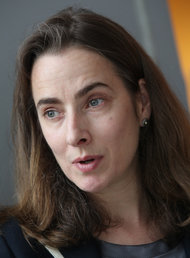She Owns It
Portraits of women entrepreneurs.
 Suzanne DeChillo/The New York Times Deirdre Lord: “I don’t think people value what they don’t pay for.”
Suzanne DeChillo/The New York Times Deirdre Lord: “I don’t think people value what they don’t pay for.”
At the most recent meeting of the She Owns It business group, we discussed pricing a new product or service, the dangers of giving something for nothing, and the reasons customers may prefer that you raise your prices.
Deirdre Lord, who owns the Megawatt Hour, talked about the particular challenges of pricing a new product or service. Her start-up offers an online platform that helps business clients manage and control their energy costs. Energy consultants offer some aspects of this service, but she is unaware of any direct competitors.
Ms. Lord said she initially thought that as a new company offering a new service, the Megawatt Hour should have a new pricing model. At first, the company charged customers based on a percentage of their projected energy bills. But businesses that purchase energy are accustomed to paying energy brokers and consultants rates that reflect a percentage of their actual energy use and not just the cost of that use. Ms. Lord’s customers began to ask how the company’s rates translated — how many tenths of a penny per kilowatt hour were they paying?
As a result, the Megawatt Hour adopted the use pricing model as well. It’s a small change, Ms. Lord said, but one that makes it easier for customers to experiment with the unfamiliar. “Asking customers to do too many new things just doesn’t work,” she said.
And there will be another change. Effective June 1, the Megawatt Hour will stop making certain features available free. “We’ve gotten people on that product and now that we’re re-evaluating products and pricing, we’re taking it away for the reason we’ve discussed: I don’t think people value what they don’t pay for,” she said.
“It’s true,” said Beth Shaw, who owns YogaFit.
The Megawatt Hour invited users of its free version to call to learn about switching to a paid offering. “We’ll see what happens,” Ms. Lord said. But regardless of whether there are any takers, she said, “We’re not really getting anything by having it be out there.”
Offering a product or service free without a specific goal in mind can be as detrimental as indiscriminate discounting, Ms. Lord said. “If you’re going to give a discount, you need to get something from the customer,” she said.
“You’re absolutely right,” Ms. Shaw said. “They need to fill out a survey or something.”
“Or you need to get them from the 30-hour training to the 50-hour training, or create some trade-off,” Ms. Lord said.
“I think it also depends on who your customer is,” said Alexandra Mayzler, who owns Thinking Caps Group, which offers high-end tutoring. “Certain people expect certain prices.”
She recalled Thinking Caps’ early prices: “I was charging a nominal amount. I must have made like minimum wage.” But then she had an “aha moment.” She recalled a parent who told her she was doing a great job, but would not be taken seriously because her prices were too low.
If you’re in a market where people are used to paying a certain price for something, they may be happy to get it for a little less, Ms. Mayzler said. That’s considered a deal. “But if it’s a lot less, you’re like, ‘What’s wrong here?’” she added. “Three times in 10 years, I had people say to me, out of the goodness of their heart, ‘I’m going to go with you, but I’m a little alarmed at the pricing, because what am I not getting?’”
Ms. Mayzler, who started her business from her college dorm room, explained why it was hard for her to raise her prices. “I had started at like $25 an hour or something as a student,” she said. “Mentally, how do you go from that, to charging the going rate, which is anywhere from $150 to $400?” She said that while she valued her time and knew she was good at what she did, “It’s very hard to wake up one day one September and charge $50 and the next charge $350.” Nonetheless, she did manage to raise prices — to $150 to $195 in New York, and less in Texas.
Still, she realized she had to increase her prices, and that Thinking Caps would serve a particular type of client. “That means that a lot of our clients do have higher expectations,” she said.
You can follow Adriana Gardella on Twitter.
Article source: http://boss.blogs.nytimes.com/2013/05/20/the-delicate-balance-between-charging-too-little-and-charging-too-much/?partner=rss&emc=rss